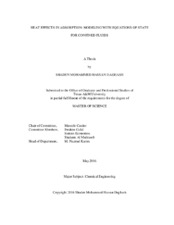| dc.contributor.advisor | Castier, Marcelo | |
| dc.creator | Daghash, Shaden Mohammed Hassan | |
| dc.date.accessioned | 2016-07-08T15:08:51Z | |
| dc.date.available | 2018-05-01T05:49:16Z | |
| dc.date.created | 2016-05 | |
| dc.date.issued | 2016-02-17 | |
| dc.date.submitted | May 2016 | |
| dc.identifier.uri | https://hdl.handle.net/1969.1/156868 | |
| dc.description.abstract | Adsorption is valuable for industrial separation and purification processes and the characterization of porous materials. The amount of adsorbate a given adsorbent can take at a given condition and the associated heat effect are among the most important data for adsorption phenomena. In particular, the study of heats of adsorption plays an important role in the assessment and optimization of energy use in industrial processes. That is because the adsorption process temperature is a key factor that controls local adsorption equilibria and dynamics within adsorption columns. There are different definitions and experimental measurement techniques of heats of adsorption, but this work’s focus is on predicting isosteric and pseudo-isosteric heats of adsorption and the difference in specific heat capacity between the adsorbed and the bulk phases of a gas on an adsorbent using an equation of state for confined fluids. The equation of state used extends the Peng-Robinson equation of state for fluids within solid spherical pores. The adsorption of a variety of pure gases on different zeolites is studied in this research. Zeolites of types A and X are the main focus as they are the adsorbents utilized in many gas adsorption-separation processes. Adsorption isotherms are correlated by means of parameter fitting and their average absolute relative deviations (AARDs) are in the range 1% – 6% for most of the studied systems. The results of isosteric and pseudo-isosteric heats of adsorption are predictions, which generally follow the qualitative experimental trends and have AARDs in the range 21% - 46%. The calculated isosteric heats were used to reflect on the zeolite heterogeneity and energetic levels and to calculate the difference in specific heat capacities. This was in the range of -0.5R to 3R, which is the same order of magnitude of results obtained from literature. | en |
| dc.format.mimetype | application/pdf | |
| dc.language.iso | en | |
| dc.subject | isosteric heats | en |
| dc.subject | adsorption | en |
| dc.subject | zeolites | en |
| dc.title | Heat Effects in Adsorption: Modeling with Equations of State for Confined Fluids | en |
| dc.type | Thesis | en |
| thesis.degree.department | Chemical Engineering | en |
| thesis.degree.discipline | Chemical Engineering | en |
| thesis.degree.grantor | Texas A & M University | en |
| thesis.degree.name | Master of Science | en |
| thesis.degree.level | Masters | en |
| dc.contributor.committeeMember | Galal, Ibrahim | |
| dc.contributor.committeeMember | Economou, Ioannis | |
| dc.contributor.committeeMember | Al Muhtaseb, Shaheen | |
| dc.type.material | text | en |
| dc.date.updated | 2016-07-08T15:08:51Z | |
| local.embargo.terms | 2018-05-01 | |
| local.etdauthor.orcid | 0000-0002-9558-8702 | |


